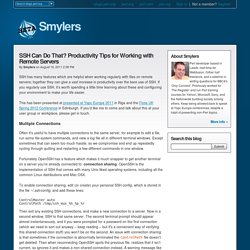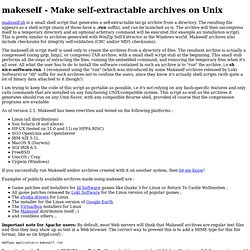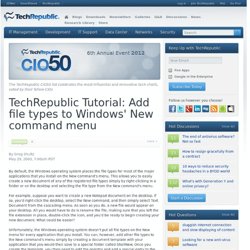

Bash. SSH Can Do That? Productivity Tips for Working with Remote Servers. SSH has many features which are helpful when working regularly with files on remote servers; together they can give a vast increase in productivity over the bare use of SSH.

If you regularly use SSH, it’s worth spending a little time learning about these and configuring your environment to make your life easier. This has been presented at presented at Yapc Europe 2011 in Riga and the Floss UK Spring 2012 Conference in Edinburgh. If you’d like me to come and talk about this at your user group or workplace, please get in touch. Multiple Connections Often it’s useful to have multiple connections to the same server, for example to edit a file, run some file-system commands, and view a log file all in different terminal windows. Fortunately OpenSSH has a feature which makes it much snappier to get another terminal on a server you’re already connected to: connection sharing. ControlMaster auto ControlPath /tmp/ssh_mux_%h_%p_%r What About Windows Users?
Copying Files Repeated Connections $ ssh www2. Shell Scripte verschlüsseln » 512M, Datei, Inhalt, Befehl, Skript, Testprogramm » IT Blögg. Ich musste ein Shellscript verschlüsseln, damit der Empfänger das gekaufte Skript nicht für sich selbst erweitern oder weiterverkaufen kann. Da bin ich bei Francisco Rosales über ein Skript gestolpert, was die ShellScripte in C übersetzt und anschliessend compiliert. Ist zwar kein 100%iger Schutz, aber benötigt Aufwand zum decompilieren was den Meisten zu viel ist. Der zuvor sehr gut lesbare und bearbeitbare Quellcode (Links) sieht dann wie Zeihenmuss (Rechts) aus. Makeself - Make self-extractable archives on Unix. Makeself.sh is a small shell script that generates a self-extractable tar.gz archive from a directory.

The resulting file appears as a shell script (many of those have a .run suffix), and can be launched as is. The archive will then uncompress itself to a temporary directory and an optional arbitrary command will be executed (for example an installation script). This is pretty similar to archives generated with WinZip Self-Extractor in the Windows world. Makeself archives also include checksums for integrity self-validation (CRC and/or MD5 checksums). The makeself.sh script itself is used only to create the archives from a directory of files. I am trying to keep the code of this script as portable as possible, i.e it's not relying on any bash-specific features and only calls commands that are installed on any functioning UNIX-compatible system. As of version 2.1, Makeself has been rewritten and tested on the following platforms :
Bash Self-Extracting Script. In this post I'll show you how to create a self extracting bash script to automate the installation of files on your system. This script requires coreutils (for cat, tail), awk, gzip, tar and bash. There are 3 parts to the Base Self-Extracting Script The Payload The Decompression Script The Builder Script Lets begin by creating our working directory and all the script files we will need. Debian Linux Backup mittels Paketlisten. Unter Debian ist es möglich das System wirklich zu sichern und nach einer Neuinstallation alles wieder in den Ursprungszustand zu versetzen.
Wir benötigen für Debian Linux Backup die Paketlisten von apt / dpkg und die Sicherung des Verzeichnisse /etc. ~# touch /etc/cron.daily/backup_paektlisten.sh Skript ausführbar machen. Shellprompt-Konfiguration. Zur Übersicht: Linux: meine Software und Konfigurationstipps Seit vielen Jahren weiß ich, dass man den Shellpromt konfigurieren kann. Aber so richtig interessiert hat mich das nie; ich habe daran nie etwas geändert. Dass ich mich nun doch damit befasst habe, ist zwei konkreten Ärgernissen zu verdanken. Die folgenden Aussagen beziehen sich auf die bash. Warum sollte man den Standard ändern wollen?
Der Standardprompt sieht bei openSUSE so aus: für normale User: username@hostname:pfad # , z.B. hl@inno:~> TechRepublic Tutorial: Add file types to Windows' New command menu. The TechRepublic CIO50 list celebrates the most influential and innovative tech chiefs, voted by their fellow CIOs By default, the Windows operating system places the file types for most of the major applications that you install on the New command's menu.

This allows you to easily create a new document of any of the registered file types simply by right-clicking in a folder or on the desktop and selecting the file type from the New command's menu. For example, suppose you want to create a new Notepad document on the desktop. If so, you'd right-click the desktop, select the New command, and then simply select Text Document from the cascading menu. As soon as you do, a new file would appear on your desktop. Unfortunately, the Windows operating system doesn't put all file types on the New menu for every application that you install. In this Daily Feature, I'll show you step-by-step the entire procedure for adding new file types to the New command’s menu. Windows versions Then, click OK. 10 Principles of the PHP Masters - NETTUTS.
Abstract Path: PowerMenu. The CGI Resource Index. PHP Shell. Advanced Bash-Scripting Guide.